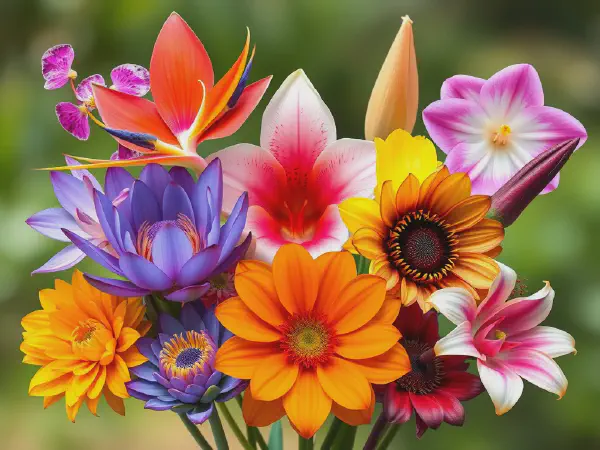Discover the 10 Unique Types of Flowers You Must Know

Exploring the Various Types of Flowers
Flowers are one of nature's most beautiful creations, providing splashes of color and a sense of joy throughout the year. The Types of Flowers found in gardens, forests, and fields can vary greatly, each unique in their shape, size, and color. Understanding the different types can help gardeners and flower enthusiasts select the best plants for their spaces.
There are many factors to consider when classifying the Types of Flowers, including their life cycles, habitats, and uses in landscaping or gardening. From vibrant annuals that bloom for just one season to hardy perennials that return year after year, each type brings its own set of benefits and aesthetics. In addition, wildflowers, tropical flowers, and flowering shrubs add diversity and variety to flower gardens, showcasing the vastness of floral beauty.
This article will delve into the Types of Flowers, providing insight into annual flowers, perennial flowers, wildflowers, tropical flowers, and flowering shrubs. By exploring the characteristics, popular varieties, and care tips for these different types, readers will gain a more comprehensive understanding of how to cultivate and enjoy their floral displays, regardless of their gardening experience.
From classic garden staples to exotic blooms, knowing the Types of Flowers available can turn any garden into a masterpiece. Florals can influence mood, attract pollinators, and enhance the overall appeal of outdoor spaces. With so many options, it’s essential to choose flowers that suit one's gardening style and environmental conditions.
In the sections that follow, we will break down each category of flowers, highlighting their unique features and how to successfully incorporate them into your landscape. Whether you're a seasoned gardener or just getting started, this guide will serve as a valuable resource for understanding the rich diversity of flowers.
Annual Flowers
Annual flowers are plants that complete their entire life cycle in a single growing season. They sprout from seeds, bloom, produce seeds, and die all within one year. Their ability to grow quickly and burst into bloom makes them a favorite among gardeners looking for vibrant, seasonal color.
Some popular annual flowers for gardens include Marigolds, Petunias, and Zinnias. Each of these flowers brings a variety of colors and shapes, ensuring that gardeners can find the perfect fit for their plots. With so many options available, annuals can be mixed and matched to create stunning floral displays.
To care for annual flowers, it's important to provide them with adequate sunlight, regular watering, and nutrient-rich soil. Deadheading spent blooms encourages further flowering, while routine fertilization can help them thrive throughout the growing season.
Perennial Flowers
Perennial flowers are those that live for more than two years, returning season after season without needing to be replanted. This makes them different from annual flowers, which must be replanted each year. Perennials are often valued for their stability and the longevity they provide in any garden setting.
Best perennial flowers for different climates include Coneflowers and Black-eyed Susans in temperate zones, Daylilies in warmer areas, and Hellebores for cooler climates. Each of these plants can adapt well to specific environmental conditions, making them excellent choices for local gardeners.
Maintenance tips for perennial flowers include regular watering, mulching to conserve moisture, and dividing overcrowded plants every few years to promote healthy growth and flowering. Regular weeding can also help keep perennials healthy and thriving.
Wildflowers
Wildflowers are native plants that grow naturally in a specific area without human intervention. They thrive in a variety of habitats, including meadows, forests, and along roadsides. Types of wildflowers such as Bluebells, Poppies, and Daisies are well-known examples that add natural beauty to landscapes.
The benefits of planting wildflowers include attracting beneficial pollinators, improving soil health, and enhancing biodiversity within a garden setting. They often require less maintenance than cultivated flowers, making them an excellent choice for low-care gardens.
To attract wildflowers to your garden, it's essential to create a suitable environment by ensuring adequate sunlight and using native seeds. You can also reduce soil disturbance and avoid using chemicals, which will foster a thriving habitat for wildflowers.
Tropical Flowers
Tropical flowers are known for their vibrant colors and exotic appearances. Common types include Hibiscus, Bird of Paradise, and Orchids, each emanating a unique beauty that can transform any indoor space or garden into a tropical paradise.
Caring for tropical flowers indoors requires providing them with a warm, humid environment, ensuring they receive adequate sunlight while avoiding direct, harsh rays. Regular watering and monthly fertilization can keep these exotic blooms healthy and thriving.
For landscaping, tropical flowers can add dramatic flair to outdoor spaces. Planting them in groups with proper spacing allows homeowners to create lush, vibrant displays that mimic their natural habitats, providing year-round interest in warmer climates.
Flowering Shrubs
Flowering shrubs are woody plants that produce blooms and can add structure and beauty to any garden. Popular types include Azaleas, Hydrangeas, and Lilacs, known for their stunning flowers that can brighten up landscapes and provide excellent privacy when planted as hedges.
The benefits of flowering shrubs in gardens include attracting pollinators, providing habitats for wildlife, and offering seasonal interest with their blooms and foliage. Their sheer variety allows for countless design possibilities in landscaping.
Pruning and care for flowering shrubs typically involve removing dead or diseased branches, shaping the plant for better growth, and fertilizing during the growing season to encourage abundant blooms. Regular watering and mulching can help keep them healthy throughout the year.
